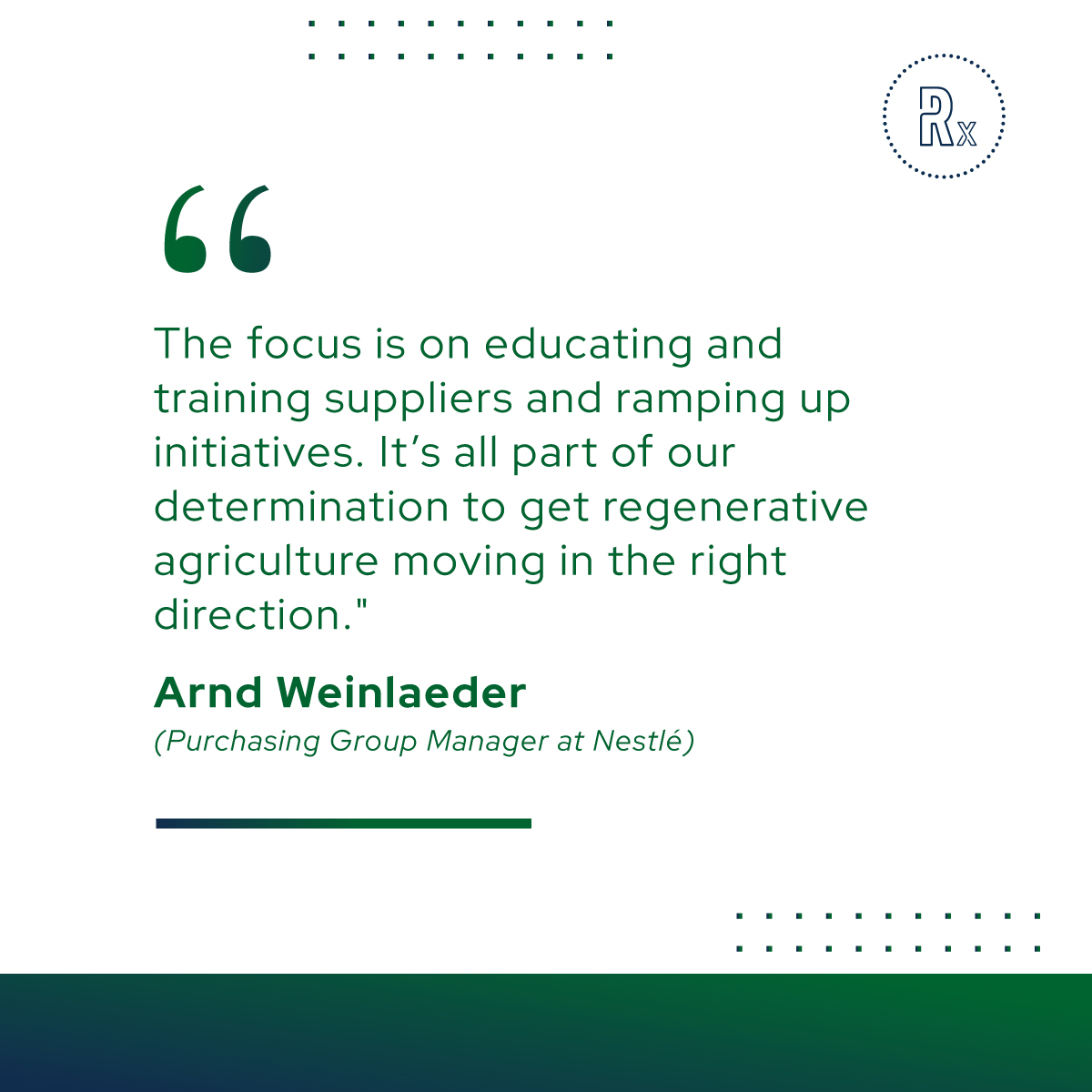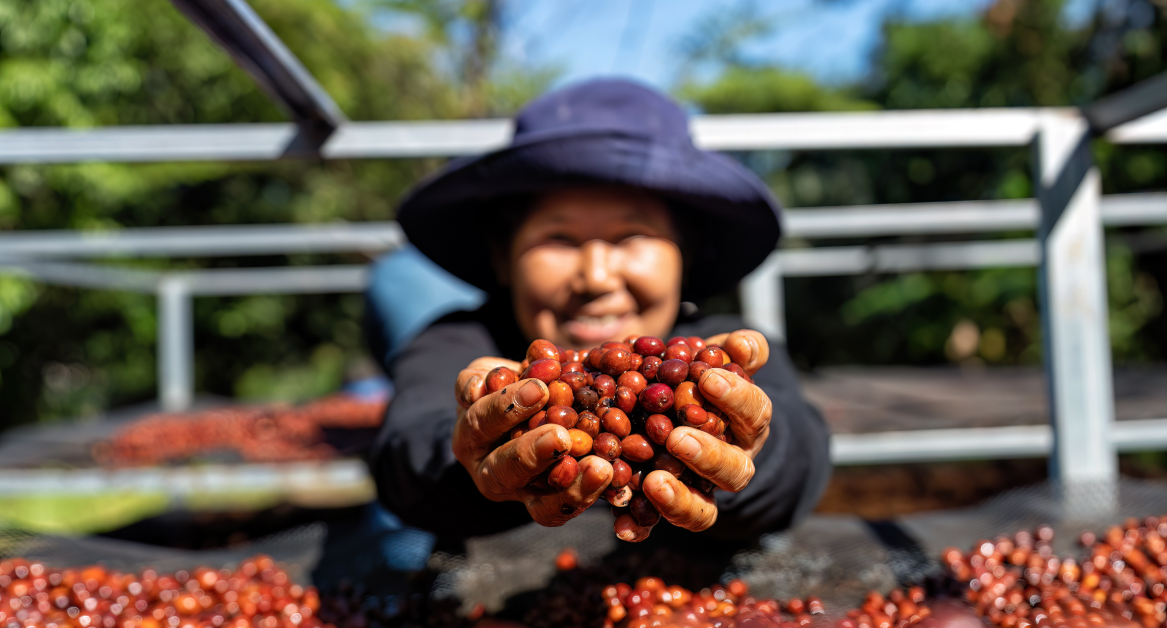The landscape of agriculture is undergoing a significant transformation toward regenerative agriculture. This shift promises to redefine our relationship with the land and shape the future of food production and environmental responsibilities.
At the forefront of this change is Nestlé, a big name in the food industry with innovative mindset in what they do. According to Nestlé statistics:
6.8% of their key ingredients were sourced through regenerative agriculture methods in 2022
20% of their key ingredients will be sourced through regenerative agriculture methods by 2025, and up to 50% in 2030.
Nestlé’s journey into regenerative agriculture represents a pivotal shift towards sustainable practices around the globe.
Nestlé’s regenerative agriculture strategy
Nestlé’s strategy for regenerative agriculture is a comprehensive approach designed to address climate change, support communities, and restore natural resources. This strategy is part of Nestlé’s Net Zero Roadmap, which acknowledges the significant role agriculture plays in greenhouse gas emissions, with nearly two-thirds of their emissions stemming from this sector.
Source: Nestlé’s Net Zero Roadmap
Improving soil health and biodiversity
Nestlé’s regenerative agriculture methods focus heavily on improving soil health and fertility. This includes practices like crop rotation, mulching, organic fertilizers, and minimizing tillage to increase soil organic matter. Healthier soils are more resilient to climate change and can increase the productivity of crops, thereby improving farmers’ livelihoods and enhancing food security.
An example in France:
These practices aid in capturing increased levels of carbon from the atmosphere in soils and plant biomass.
Biodiversity, collective & landscape actions
A key component of Nestlé’s strategy involves safeguarding and increasing biodiversity, both above and below ground. The company aims to enhance plant life with diversified crops, intercropping, and planting cover crops between harvests. This also includes introducing more abundant animal life like microbes, fungi, invertebrates, insects, and bird life, which contribute to improved soil nutrient cycles, pollination, fertility, and productivity.
Additionally, Nestlé plans to plant 200 million trees by 2030 in the farms and landscapes from which it sources, providing cocoa plants with protection and enhancing ecosystems.
Water security and quality
Protecting water resources and stewarding scarce water resources are crucial to Nestlé’s regenerative agriculture practices. The company employs strategic approaches to irrigation, such as sprinkler, drip, and sub-surface irrigation, to minimize water evaporation and prevent over-use.
Nestlé also aims to reduce chemical farm inputs and optimize organic fertilization and biological pest control to reduce run-off, thereby ensuring water security and quality.
Integrating livestock and diverse cropping systems
Where feasible, Nestlé integrates livestock into farming systems and optimizes grazing. This is part of their effort to turn dairy into a net-zero industry, using methods like silvopasture and mixed farming of livestock and crops.
These approaches provide benefits such as organic fertilization, improved water management, and additional sources of farm income.
Investment and support for farmers
Nestlé is investing CHF 1.2 billion over five years to encourage regenerative agriculture in its supply chain. This investment includes applying state-of-the-art science and technology, providing technical assistance, offering investment support for the transition to regenerative agriculture, and paying premiums for goods produced using regenerative practices.
As their purchasing group manager has pointed out, Nestlé extremely prioritizes the collaboration and education of farmers and suppliers in reaching their sustainable goals.

In short, Nestlé’s regenerative agriculture strategy is a multi-faceted approach that encompasses soil health, biodiversity enhancement, water resource management, integration of livestock, and significant investment to support farmers.
Investment and progress
Investments in regenerative agriculture
Financial commitment and sustainability promise
Nestlé’s journey into regenerative agriculture is underpinned by a robust financial commitment, exemplified by their investment of 1.2 billion Swiss francs ($1.29 billion) over the next five years to support and accelerate the transition to regenerative agriculture across their global supply chain.
This investment is part of Nestlé’s broader Sustainability Promise, which aims to advance regenerative food systems on a global scale. By funneling resources into these initiatives, Nestlé demonstrates a genuine commitment to driving positive change in the industry.
Farmer connect program and initiatives
Central to Nestlé’s strategy is the Farmer Connect program, a comprehensive initiative that collaborates with over 500,000 farmers and 150,000 suppliers. This program is not just about financial assistance; it’s a platform for introducing and scaling up regenerative farming practices.
These practices include crop rotation, mulching, and the use of organic fertilizers, all contributing to enhanced soil health, increased productivity, and ultimately, more sustainable farming landscapes.
Progress and future targets
Currently,
In 2022, Nestlé achieved a significant milestone in its regenerative agriculture journey. Twenty percent of their key ingredients were sourced through regenerative methods, encompassing a diverse array of products like fresh milk, Ecuadorian cocoa, green coffee, and various vegetables. This achievement marks a crucial step in Nestlé’s commitment to transform its supply chain and pave the way for more sustainable agricultural practices.
Future goals and targets:
Looking ahead, Nestlé has set ambitious targets for the coming years. By 2025, the company aims to source 50% of its key ingredients through regenerative agricultural methods. This target is not just a number; it represents a substantial volume, estimated at around 14 million tonnes, reflecting Nestlé’s commitment to scaling up these practices significantly.
Biodiversity and ecosystem actions
Nestlé’s approach to regenerative agriculture extends beyond the farm to the wider ecosystem. A key aspect of this approach is their biodiversity initiative, which includes a goal to plant 200 million trees by 2030. These trees, ranging from shade to fruit-bearing varieties, will not only provide protection to crops but also enhance the overall biodiversity, contributing to healthier soil nutrient cycles and increased crop productivity.
On-the-ground initiatives
Nestlé’s commitment to regenerative agriculture is not just a theoretical pursuit; it’s a practical, on-the-ground reality transforming the way farming is done. The company’s initiatives across various supply chains offer a glimpse into the tangible impact of these practices.
Digiorno pizza wheat and tomato farms initiatives
Regenerative practices in wheat farms
In a significant move to bolster sustainable agriculture, Nestlé has invested in regenerative practices on wheat farms within its DiGiorno pizza brand supply chain. This project covers over 100,000 acres of farmland, nearly double the area needed to grow the wheat used in DiGiorno pizza crusts. By adopting regenerative agriculture, these farms aim to enhance soil health, biodiversity, and overall sustainability.
Partnerships for implementation
Key to this initiative’s success are Nestlé’s partnerships with primary wheat flour suppliers ADM and Ardent Mills. These collaborations extend across farms in Kansas, North Dakota, Indiana, and Missouri, integrating regenerative practices into their operations. This cooperative approach demonstrates the power of shared commitments in achieving large-scale agricultural transformation.
Environmental and economic outcomes
The environmental and economic benefits of these regenerative practices are evident. For example, ADM’s 2022 report highlighted that over 50% of the wheat farms in the program used cover crops, contributing to the sequestration of more than 3,800 metric tons of CO2. Farmers like Scott Stroberg from Kansas have witnessed firsthand the improvements in soil health and yield, coupled with financial benefits from reduced reliance on synthetic chemicals.
Tomato supply chain regenerative efforts
Promoting regenerative farming in tomato production
Nestlé’s regenerative efforts extend to its tomato supply chain in the U.S., where they work with farmers to implement sustainable farming practices. This commitment reflects a broader shift in the agricultural sector towards more ecologically sound methods, which Nestlé is actively supporting and scaling up.
Third-party verification and accountability
A critical aspect of these initiatives is third-party verification. Nestlé collaborates with Leading Harvest and other organizations to certify the farming practices of its tomato suppliers. This process ensures that the regenerative practices are effective, efficient, and accountable, aligning with the company’s sustainability goals and commitments.
Libby’s pumpkin and other brands’ initiatives
Regenerative agriculture in pumpkin farming
In central Illinois, Nestlé works with pumpkin farmers supplying Libby’s, supporting the adoption of regenerative agriculture practices. These efforts not only benefit the environment but also contribute to producing healthier, more sustainable ingredients.
Impact across various brands
Nestlé’s implementation of regenerative practices is not confined to one product line. It encompasses various brands, including Carnation, Carnation Breakfast Essentials, and Purina. This broad approach underscores Nestlé’s commitment to a sustainable, regenerative future in food production, going beyond individual products to encompass a company-wide philosophy.
Nestlé’s initiative signifies a global shift toward Regen Ag.
Nestlé’s journey in regenerative agriculture marks a significant step towards sustainable farming. By integrating practices that enhance soil health, biodiversity, and water conservation, and by investing in farmer support, Nestlé is not only improving its supply chain but also setting a new standard for the industry.
As we move forward, Nestlé’s initiatives serve as a blueprint for others in the industry, highlighting that a sustainable approach to agriculture is not just beneficial for the environment but also viable and profitable for the global food system.
In Asia, RegenX, the only regenerative agriculture financing platform, aligns with this worldwide shift. We are providing crucial pre-harvest financing from eco-investors, thereby reducing their financial burdens and enhancing access to more profitable farm-gate prices. Additionally, with our data platform, you are well-informed about the impacts you create when choosing RegenX.
🌈 Explore more at regenx.ag



